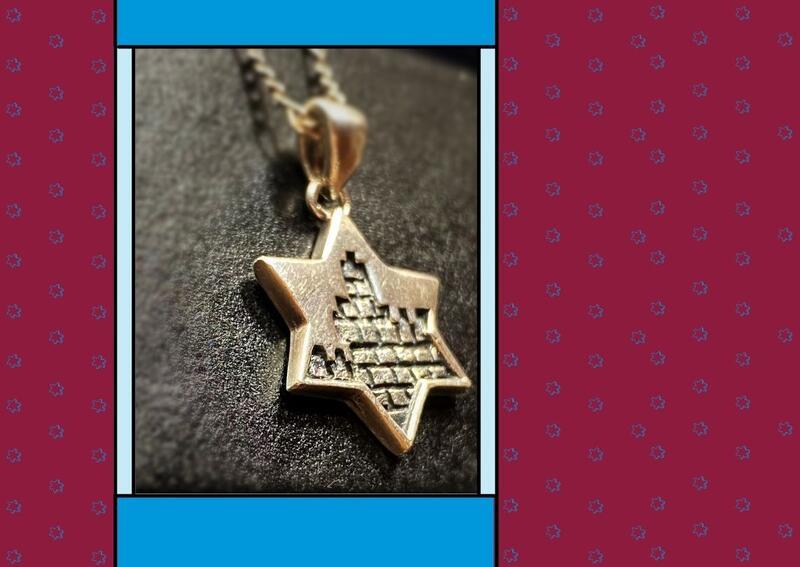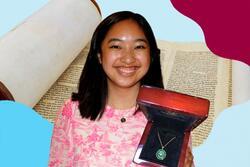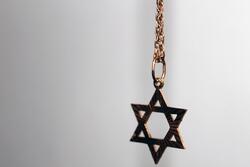How My Star of David Necklace Helped Me Understand My Jewish Identity
I got my Star of David necklace in Israel when I went in seventh grade for my Bat Mitzvah trip. I found it in a little jewelry stall with all different shapes, sizes, colors, and styles of Judaic jewelry. For several minutes, I looked all around the shop to find the ideal piece of jewelry for me. As soon as I saw the charm, I knew it was perfect: silver, medium-sized, and in the center, instead of a small open space, there lay an image of Jerusalem's old city walls and ramparts. The cracks between the bricks were already tarnished, giving it an old look. Now, I wear the necklace almost every day. Over the years, however, I’ve noticed the attention it attracts, especially in contrast with my Christian peers who wear cross necklaces.
People have asked me why I always wear “my little Jewish thingy,” and, at school, I’ve been pegged as the “Jewish girl”—like religion is my only personality trait because I’m open about my faith (I do quite literally wear it on my chest.) When we learn about Judaism and the Holocaust in classes, fellow students frequently look to me and my star as they realize it’s the same symbol that victims of the camps wore. A teacher once asked me if the image on my necklace was of Auschwitz (as if to the Jewish people the only thing of relevance is the Holocaust.) Classmates wearing crosses aren’t labeled as “Christian kids.” Instead, I often hear them praised for their great taste in accessories—especially the bigger and flashier the cross is (a palm sized Star of David with rhinestones on it would probably be considered tacky or weird). When we learn about Christianity in class, no one points to the kids wearing crosses, and no one would ever mistake an old Christian religious symbol for a depiction of mass murder. These small double standards didn't seem like much, until they’d all built up and I was old enough to recognize them as microaggressions.
The Star of David marks us today—and while I experience microaggressions surrounding it, it's not in the way that the Nazis used it to separate and discriminate against Jews—the emblem differentiates Jews in a sacred special way: In a world where Jewish people come in all shapes, sizes, and ethnicities, this little star helps us recognize and connect to one another. Frequently, when I’m shopping or walking downtown, I run into people wearing the Star of David on a necklace or other pieces of jewelry. Sometimes, I choose to strike up casual conversation, and I tell these people that I like their jewelry. This creates an instant connection between the stranger and myself: we’re tied together by our shared Jewish history and pride.
Learning about the Star of David's history has given me a new perspective whenever I see it as well. While some scholars argue that King David's army engraved the Star of David on their shields, cementing the name Magen (shield) of David, others have a more mystical point of view; they claim that the star is a knot representing the physical plane and the holy realm of G-d, with the three points on each side representing the Torah, G-d, and the people of Israel. Children and grandchildren of Jewish women in Spain and the Ottoman Empire claim that their mothers were able to heal the sick by using amulets with the Magen David engraved onto them. Meanwhile, my kabbalah-practicing Sephardic ancestors declare that the six points plus the center represent the seven G-dly attributes on which the world was founded: chesed (kindness), gevurah (severity), tiferet (harmony), yesod (foundation), malchut (royalty), netzach (perseverance), and hod (splendor). Archaeologists have discovered engravings of the symbol on synagogue walls from the third century CE, as well as on early Jewish textiles and tombstones. The Magen David eventually gained global recognition when Zionists used it as their symbol in 1897, and, as discussed, it later became even more recognizable when it was used to mark Jews during the Holocaust.
Through researching the star and my own connection to it, I realized that this symbol also has a more unique and personal meaning for me given my middle name. My middle name is Xitlali (sit-la-li), which means “star” in the Aztec language of Nahuatl. While this emblem is significant to my Jewish side, I’ve realized that it can coexist with my Mexican side too. At the end of the day, two triangles crossed over one another is just that. A symbol is something that I as a human can make as significant or as non significant as I would like it to be.
By looking at its past, I can see ancient oral tradition, religious practices, and mystical stories, along with historical events, and times of great communal pain. This symbol's history shows the diversity of the Jewish people, and I’ve come to realize that these are all critical aspects of being Jewish. The Star of David and its history helps me understand the different layers of my Jewish identity; the symbol doesn’t just represent the Jewish people, it represents the different cultures we’ve embraced as part of the diaspora, including Jews of all races and who speak many languages such as Ladino and Yiddish. The star represents my people’s spiritual traditions and our physical existence. It grounds me to continue to explore my own, unique Jewish identity.
This piece was written as part of JWA’s Rising Voices Fellowship.







you can fit every letter in the English and Hebrew alphabet in the star of David
I hope I’m allowed to comment on this lovely piece z I’m not Jewish but I am so touched by your beautiful story. I’ve gone on to buy a Star of David as a symbol of good luck and in remembrance of my mother in law’s good Jewish friend who she had for over sixty six years. Anna was an inspiration to me and my husband’s family. I wear it with Anna’s memory every day .
I didn't realize that we are not suppose to strike conversation if we are outsiders. This is good to know so I will not ask questions or approach.
What a lovely article, Sofia. When I was in middle school my mom gave me a charm bracelet. My favorite charm was the beautiful Star of David with my birth stone. I wore it on special occasions. My daughter is in her 20's and she now wears it for special occasions too. Mother-daughter-hand-me-downs are precious. There are so few of us Jews in the world today. I imagine that thousands of years ago, we were simply all extended family members.
Such a beautiful article Sofia. :)
Yes Sofia! You are my favorite witch ever.
This post resonated so much with me. A small star of David was also given to me at a young age & I wore it often, liking its enameled colors of white & blue with gold trim, but then it became more than jewelry. It signified my religion, which was problematic in 1940's-50's Los Angeles, where anti-semitism & racism were openly indulged in. Eventually my star ended in a drawer; I may have given it away. So thank you, Sofia, by bringing it back. I'm also Sephardic on my father's side. Henri(etta)
Beautiful and thoughtful article.
Well done Sofia.
This was inspiring. I applaud the very well written content and am so proud. You have expressed what we Jews feel. Congrats.
What a beautiful article! Your words touched my heart and my own values. Thank you for your strength, pride and understanding of an identity you possess.
Keep writing!
Thank you for this article. Last year I realized that I am jewish and thankful.
Congratulations Sofia. Nice write up. I am proud of you!